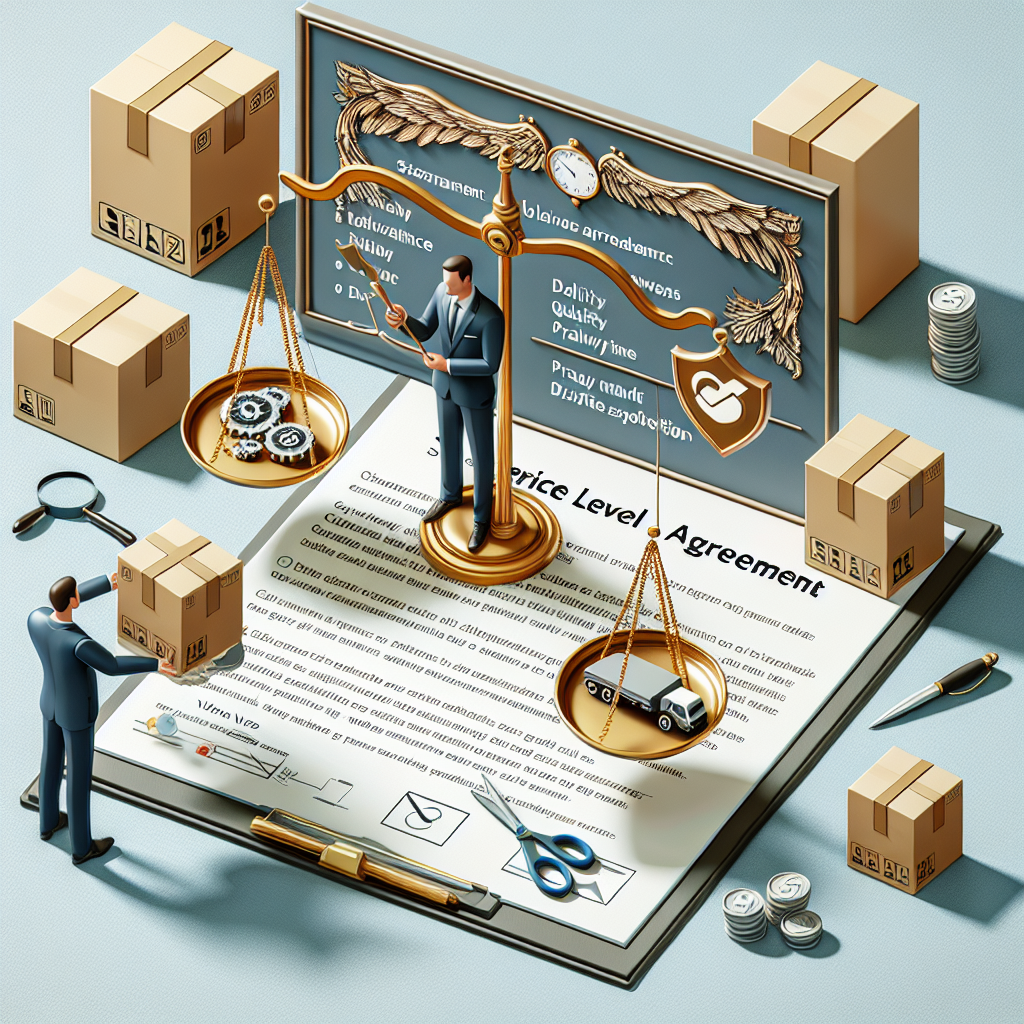Your cart is currently empty!
Tag: Vendors

The Benefits of Establishing Service Level Agreements (SLAs) with Vendors
Service Level Agreements (SLAs) are essential tools in business relationships, especially when it comes to working with vendors. An SLA is a contract between a service provider and a customer that outlines the level of service that will be provided, as well as the metrics that will be used to measure that service. Establishing SLAs with vendors can bring a number of benefits to your business.One of the key benefits of establishing SLAs with vendors is that it helps to ensure that both parties are on the same page when it comes to expectations. By clearly outlining what services will be provided, as well as the quality and timeliness of those services, both the vendor and the customer can avoid misunderstandings and disputes down the line. This can help to build trust and strengthen the relationship between the two parties.
Another benefit of SLAs is that they provide a framework for measuring the vendor’s performance. By specifying metrics such as response times, resolution times, and uptime guarantees, both parties can track the vendor’s performance and hold them accountable for meeting their commitments. This can help to ensure that the vendor is delivering the level of service that was promised, and can provide a basis for discussing any issues or concerns that arise.
Establishing SLAs can also help to improve the overall quality of the services that are being provided. By setting clear expectations and standards for performance, vendors are motivated to deliver high-quality service in order to meet or exceed those standards. This can lead to improved efficiency, productivity, and customer satisfaction, as well as a reduction in errors and delays.
In addition, SLAs can help to streamline communication and problem resolution between the vendor and the customer. By clearly defining the processes for reporting and resolving issues, both parties can work together more effectively to address any problems that arise. This can help to minimize downtime, reduce disruptions to business operations, and ultimately improve the overall customer experience.
Overall, establishing SLAs with vendors can bring a number of benefits to your business, including improved communication, better performance tracking, and higher-quality service delivery. By setting clear expectations and standards for performance, both parties can work together more effectively to achieve their goals and build a strong and successful business relationship.

Negotiating SLAs with Vendors: Tips for Success
Negotiating service level agreements (SLAs) with vendors is a crucial aspect of any business relationship. A well-crafted SLA can help ensure that both parties are clear on their expectations and responsibilities, leading to a more successful and productive partnership. However, negotiating SLAs can be a complex process, requiring careful consideration and communication. Here are some tips for negotiating SLAs with vendors to ensure a successful outcome.1. Define your objectives: Before entering into negotiations with a vendor, it is important to clearly define your objectives and priorities for the SLA. What are the key services or deliverables that you expect from the vendor? What are the critical performance metrics that you want to measure and monitor? By setting clear goals and objectives, you can ensure that the SLA is tailored to meet your specific needs.
2. Understand the vendor’s capabilities: It is important to have a good understanding of the vendor’s capabilities and limitations before negotiating an SLA. What resources does the vendor have available to meet your requirements? Are there any potential challenges or constraints that could impact their ability to deliver on the SLA? By understanding the vendor’s capabilities, you can negotiate a more realistic and achievable SLA.
3. Establish clear metrics and KPIs: One of the key components of an SLA is the establishment of clear metrics and key performance indicators (KPIs) to measure the vendor’s performance. These metrics should be specific, measurable, achievable, relevant, and time-bound (SMART). By defining clear metrics and KPIs, both parties can track progress and performance, and address any issues or discrepancies in a timely manner.
4. Build in flexibility: It is important to build flexibility into the SLA to accommodate changing business needs and circumstances. Include provisions for revising or updating the SLA as needed, and establish a process for reviewing and amending the agreement on a regular basis. By building in flexibility, you can ensure that the SLA remains relevant and effective over time.
5. Communicate openly and transparently: Effective communication is key to successful SLA negotiations. Be open and transparent with the vendor about your expectations, requirements, and concerns. Listen to the vendor’s feedback and input, and be willing to compromise and find common ground. By fostering a collaborative and constructive dialogue, you can build a stronger and more positive relationship with the vendor.
Negotiating SLAs with vendors can be a challenging but rewarding process. By following these tips, you can ensure that the SLA is tailored to meet your specific needs and expectations, and establish a strong foundation for a successful partnership with your vendor.

Negotiating Service Level Agreements (SLAs) with Vendors and Partners
Negotiating Service Level Agreements (SLAs) with vendors and partners is a critical aspect of any business relationship. An SLA is a formal contract that outlines the expectations, responsibilities, and deliverables of both parties involved in a business partnership. It sets clear guidelines for the level of service that is expected, as well as the consequences if those expectations are not met.When negotiating an SLA with a vendor or partner, there are several key factors to consider. The first step is to clearly define the scope of the agreement. This includes outlining the specific services that will be provided, the expected outcomes, and the timeline for delivery. It is important to be as specific as possible in defining these terms to avoid any misunderstandings or disputes later on.
Another important consideration when negotiating an SLA is to establish measurable performance metrics. This could include metrics such as response time, resolution time, uptime, and customer satisfaction. These metrics should be realistic and achievable, and should be regularly monitored and reviewed to ensure that both parties are meeting their obligations.
In addition to performance metrics, it is also important to include provisions for escalation and dispute resolution in the SLA. This ensures that any issues or disagreements that arise during the course of the partnership can be resolved in a timely and fair manner. It is also important to include provisions for regular review and amendment of the SLA to ensure that it remains relevant and effective over time.
When negotiating an SLA, it is important to be clear and transparent about expectations and requirements. Both parties should have a clear understanding of their roles and responsibilities, as well as the consequences of failing to meet those obligations. It is also important to establish a strong line of communication between both parties to ensure that any issues or concerns are addressed promptly and effectively.
In conclusion, negotiating Service Level Agreements with vendors and partners is a crucial step in establishing a successful business relationship. By clearly defining the scope of the agreement, establishing measurable performance metrics, and including provisions for escalation and dispute resolution, businesses can ensure that both parties are meeting their obligations and delivering the level of service expected. By following these guidelines, businesses can establish strong and productive partnerships that benefit both parties involved.

Negotiating Service Level Agreements with Vendors and Partners
Negotiating Service Level Agreements (SLAs) with vendors and partners is a crucial aspect of any business relationship. These agreements define the level of service that the vendor or partner is expected to provide, ensuring that both parties are clear on their responsibilities and the expectations for the partnership. By negotiating SLAs effectively, businesses can ensure that their needs are met and that they are receiving the best possible service from their vendors and partners.When negotiating SLAs with vendors and partners, it is important to consider several key factors. First and foremost, it is essential to clearly define the scope of the services that will be provided. This includes outlining the specific tasks that the vendor or partner will be responsible for, as well as any performance metrics that will be used to measure their success.
In addition to defining the scope of the services, it is also important to establish clear expectations for response times and resolution times. This ensures that both parties are on the same page regarding how quickly issues will be addressed and resolved, preventing any misunderstandings or conflicts down the line.
Another key consideration when negotiating SLAs is the pricing structure. It is important to clearly outline the costs associated with the services being provided, as well as any additional fees or charges that may apply. By negotiating a fair and transparent pricing structure, businesses can avoid any surprises or disputes over costs in the future.
Finally, it is important to include provisions for monitoring and reporting in the SLA. This allows both parties to track the performance of the services being provided and ensure that the agreed-upon standards are being met. By including these provisions in the SLA, businesses can hold their vendors and partners accountable for their performance and address any issues that may arise in a timely manner.
In conclusion, negotiating service level agreements with vendors and partners is a critical step in establishing successful business relationships. By clearly defining the scope of services, setting expectations for response and resolution times, establishing a fair pricing structure, and including provisions for monitoring and reporting, businesses can ensure that they are receiving the best possible service from their vendors and partners. By negotiating SLAs effectively, businesses can set the foundation for a strong and mutually beneficial partnership that will help them achieve their goals and drive success in the long term.

Negotiating Service Level Agreements with Vendors: Tips and Best Practices
Negotiating service level agreements (SLAs) with vendors is a crucial aspect of any business relationship. An SLA is a formal contract between a vendor and a client that outlines the expected level of service, performance metrics, and responsibilities of each party. By setting clear expectations upfront, both parties can ensure a successful partnership and avoid any misunderstandings down the line.Here are some tips and best practices for negotiating SLAs with vendors:
1. Define your requirements: Before entering into negotiations with a vendor, it’s important to clearly define your requirements and expectations. This includes identifying key performance indicators (KPIs), service levels, and any specific deliverables that are important to your business. Having a clear understanding of what you need will help you negotiate more effectively and ensure that the SLA meets your needs.
2. Set realistic expectations: When negotiating SLAs, it’s important to set realistic expectations for both parties. Make sure that the service levels and performance metrics outlined in the SLA are achievable and in line with industry standards. Setting unrealistic expectations can lead to dissatisfaction and ultimately, a breakdown in the vendor-client relationship.
3. Include penalties and incentives: SLAs should include penalties for non-performance as well as incentives for exceeding performance targets. Penalties can help incentivize vendors to meet their obligations, while incentives can encourage them to go above and beyond to deliver exceptional service. By including these provisions in the SLA, both parties are motivated to meet or exceed expectations.
4. Establish clear communication channels: Effective communication is key to a successful vendor-client relationship. Make sure that the SLA includes provisions for regular communication, reporting, and issue resolution. Establish clear channels for communicating with the vendor, such as regular meetings or status updates, to ensure that both parties are on the same page.
5. Review and revise regularly: SLAs should not be set in stone. It’s important to regularly review and revise the SLA to ensure that it continues to meet the needs of both parties. As your business evolves and changes, so too should the SLA. By regularly reviewing and revising the SLA, you can ensure that it remains relevant and effective in guiding the vendor-client relationship.
In conclusion, negotiating service level agreements with vendors requires careful consideration and planning. By following these tips and best practices, you can ensure that your SLA is effective in setting clear expectations, incentivizing performance, and fostering a successful partnership with your vendors.

Best Practices for Negotiating Service Level Agreements (SLAs) with Vendors
When it comes to negotiating Service Level Agreements (SLAs) with vendors, it is important to establish clear expectations and guidelines to ensure a successful working relationship. SLAs are formal agreements that outline the level of service that a vendor will provide to a client, including the quality, availability, and performance of services. Here are some best practices to consider when negotiating SLAs with vendors:1. Define clear and measurable service levels: Before entering into negotiations with a vendor, it is important to clearly define the services that will be provided and establish measurable metrics for performance. This will help both parties understand what is expected and ensure accountability.
2. Set realistic and achievable goals: When negotiating SLAs, it is important to set goals that are realistic and achievable. Unrealistic expectations can lead to dissatisfaction and conflict down the line. It is important to consider factors such as the vendor’s capabilities, resources, and limitations when setting goals.
3. Establish consequences for non-compliance: In the event that a vendor fails to meet the agreed-upon service levels, it is important to establish consequences for non-compliance. This could include penalties, refunds, or termination of the agreement. Clearly outlining these consequences will help motivate vendors to meet their obligations.
4. Include provisions for monitoring and reporting: It is essential to include provisions for monitoring and reporting in the SLA. This will allow both parties to track performance and identify any issues that may arise. Regular reporting and communication will help ensure that service levels are being met and provide an opportunity to address any concerns in a timely manner.
5. Consider flexibility and scalability: When negotiating SLAs, it is important to consider flexibility and scalability. Business needs may change over time, and it is important to have provisions in place to accommodate these changes. This could include the ability to adjust service levels, add or remove services, or scale up or down as needed.
6. Involve key stakeholders: When negotiating SLAs with vendors, it is important to involve key stakeholders from both parties. This could include representatives from IT, procurement, legal, and other relevant departments. Involving key stakeholders will help ensure that the agreement meets the needs of the organization and that all concerns are addressed.
In conclusion, negotiating SLAs with vendors requires careful planning, clear communication, and a focus on mutual understanding and collaboration. By following these best practices, organizations can establish successful partnerships with vendors and ensure the delivery of high-quality services that meet their business needs.

Negotiating Service Level Agreements with Vendors and Suppliers
Negotiating service level agreements (SLAs) with vendors and suppliers is a crucial aspect of any business relationship. An SLA outlines the terms and conditions under which a vendor or supplier will provide goods or services to a company, including performance standards, delivery timelines, and quality expectations. By setting clear expectations and responsibilities in an SLA, both parties can ensure a successful and mutually beneficial partnership.When negotiating SLAs with vendors and suppliers, there are several key factors to consider. First and foremost, it is important to clearly define the scope of the agreement. This includes outlining the specific goods or services that will be provided, as well as any limitations or exclusions. By clearly defining the scope of the agreement, both parties can avoid misunderstandings and disputes down the line.
Another important factor to consider when negotiating SLAs is setting measurable performance standards. This includes establishing key performance indicators (KPIs) that will be used to evaluate the vendor or supplier’s performance. By setting clear, measurable goals, both parties can track progress and ensure that the agreed-upon standards are being met.
In addition to performance standards, it is also important to establish clear timelines and deadlines in an SLA. This includes setting specific delivery dates for goods or services, as well as outlining any penalties or consequences for missed deadlines. By setting clear timelines and deadlines, both parties can ensure that expectations are being met and that the partnership remains on track.
Quality expectations are another important factor to consider when negotiating SLAs with vendors and suppliers. This includes outlining the quality standards that the vendor or supplier is expected to meet, as well as any processes or procedures that will be used to ensure quality control. By setting clear quality expectations, both parties can ensure that the goods or services provided meet the required standards.
Finally, it is important to consider the financial aspects of an SLA when negotiating with vendors and suppliers. This includes outlining pricing terms, payment schedules, and any additional fees or charges that may apply. By clearly defining the financial aspects of the agreement, both parties can ensure that there are no surprises or misunderstandings when it comes to payment terms.
In conclusion, negotiating service level agreements with vendors and suppliers is an essential part of any business relationship. By setting clear expectations, measurable performance standards, and quality expectations, both parties can ensure a successful and mutually beneficial partnership. By considering the key factors outlined above, businesses can negotiate SLAs that are fair, transparent, and effective.

How to Negotiate and Establish Service Level Agreements with Vendors
Negotiating and establishing service level agreements (SLAs) with vendors is a crucial step in ensuring that your business receives the quality of service it expects. SLAs outline the level of service that a vendor is expected to provide, including performance metrics and responsibilities. By negotiating and establishing these agreements, you can set clear expectations, hold vendors accountable, and ultimately improve the efficiency and effectiveness of your business operations.Here are some key steps to help you negotiate and establish SLAs with vendors:
1. Clearly define your requirements: Before entering into negotiations with a vendor, it is important to clearly define your requirements and expectations. This includes identifying the specific services that you require, the quality standards that must be met, and any key performance indicators that will be used to measure the vendor’s performance.
2. Conduct thorough research: Before entering into negotiations, it is important to research potential vendors and their capabilities. This will help you assess their ability to meet your requirements and determine whether they are a good fit for your business. It is also important to research industry standards and best practices for SLAs, so that you can negotiate terms that are fair and reasonable.
3. Communicate openly and transparently: Effective communication is key to successful negotiations. Be clear and transparent about your requirements, expectations, and any concerns or issues that you may have. It is important to establish a dialogue with the vendor and work together to find mutually agreeable terms.
4. Negotiate terms that are fair and reasonable: When negotiating SLAs with vendors, it is important to strike a balance between your requirements and the vendor’s capabilities. Be prepared to compromise on certain terms, but also be firm on key requirements that are critical to your business operations. It is also important to ensure that the SLA is fair and reasonable for both parties, so that it is sustainable in the long term.
5. Document the agreement: Once the terms of the SLA have been negotiated and agreed upon, it is important to document the agreement in writing. This will help to avoid misunderstandings and disputes in the future, and provide a clear reference point for both parties. The SLA should clearly outline the services to be provided, performance metrics, responsibilities, and any penalties or incentives for meeting or failing to meet the agreed-upon terms.
6. Monitor and evaluate performance: After the SLA has been established, it is important to monitor the vendor’s performance regularly and evaluate whether they are meeting the agreed-upon terms. This may involve tracking key performance indicators, conducting regular reviews with the vendor, and soliciting feedback from internal stakeholders. If the vendor is not meeting the agreed-upon terms, it may be necessary to take corrective action or renegotiate the SLA.
Negotiating and establishing SLAs with vendors is a critical step in ensuring that your business receives the level of service it expects. By following these key steps and best practices, you can set clear expectations, hold vendors accountable, and ultimately improve the efficiency and effectiveness of your business operations.

The Benefits of Establishing Service Level Agreements with Your Vendors
In today’s fast-paced business world, it’s crucial for companies to establish strong partnerships with their vendors to ensure smooth operations and efficient supply chain management. One way to do this is by creating Service Level Agreements (SLAs) with your vendors.An SLA is a contract between a company and its vendor that outlines the services to be provided, the quality standards to be met, and the metrics for measuring performance. By establishing SLAs with your vendors, you can enjoy a wide range of benefits that can help improve your business operations and drive growth.
One of the key benefits of having SLAs in place is that they help create clear expectations between you and your vendors. By clearly defining the services to be provided, the quality standards to be met, and the timelines for delivery, both parties can ensure that they are on the same page and working towards a common goal. This can help prevent misunderstandings and disputes down the line, leading to smoother and more efficient business operations.
SLAs also help to hold vendors accountable for their performance. By setting specific metrics for measuring performance, such as response times, delivery times, and quality standards, you can track and monitor your vendors’ performance and address any issues that may arise. This can help ensure that your vendors are meeting their commitments and delivering the level of service that your company requires.
Additionally, SLAs can help improve the overall quality of the services provided by your vendors. By setting clear quality standards and performance metrics, you can push your vendors to continuously improve their processes and deliver better results. This can lead to higher levels of customer satisfaction, increased efficiency, and ultimately, better business outcomes for your company.
Lastly, having SLAs in place can help you better manage your vendor relationships and drive cost savings. By setting clear expectations and performance metrics, you can identify areas for improvement and negotiate better terms with your vendors. This can lead to more competitive pricing, improved efficiency, and ultimately, cost savings for your company.
In conclusion, establishing Service Level Agreements with your vendors can bring a wide range of benefits to your business. From creating clear expectations and holding vendors accountable to driving cost savings and improving service quality, SLAs can help strengthen your vendor relationships and drive business growth. If you haven’t already done so, consider implementing SLAs with your vendors to take your business operations to the next level.

Negotiating Service Level Agreements (SLAs) with Vendors: Best Practices and Tips
Service Level Agreements (SLAs) are a crucial component of any business contract with a vendor. These agreements outline the level of service that the vendor will provide, including response times, uptime guarantees, and other key performance indicators. Negotiating SLAs with vendors can be a complex process, but with the right approach and best practices, you can ensure that you are getting the level of service that your business needs.One of the first steps in negotiating SLAs with vendors is to clearly define your requirements and expectations. This includes identifying the key performance indicators that are most important to your business, such as response times, uptime guarantees, and service availability. By clearly outlining your needs, you can ensure that the vendor understands what is expected of them and can tailor their service offerings accordingly.
When negotiating SLAs with vendors, it is important to be realistic and reasonable in your expectations. While it is important to push for the best possible service levels, it is also important to consider the vendor’s capabilities and limitations. By being flexible and open to compromise, you can ensure that the final SLA is fair and achievable for both parties.
Another best practice when negotiating SLAs with vendors is to include specific metrics and measurement processes in the agreement. This allows both parties to track performance against the agreed-upon standards and provides a basis for evaluating the vendor’s performance. By including these metrics in the SLA, you can hold the vendor accountable for meeting their obligations and ensure that you are getting the level of service that you are paying for.
It is also important to establish clear communication channels and escalation procedures in the SLA. This ensures that any issues or disputes can be quickly addressed and resolved, minimizing the impact on your business operations. By outlining these processes in the agreement, you can ensure that both parties are on the same page and can work together effectively to resolve any issues that may arise.
In addition to these best practices, there are a few key tips to keep in mind when negotiating SLAs with vendors. First, be sure to thoroughly review and understand the terms of the agreement before signing. This includes reviewing all service level commitments, penalties for non-compliance, and dispute resolution processes. By fully understanding the terms of the agreement, you can avoid any surprises or misunderstandings down the line.
Second, be sure to negotiate a fair and reasonable pricing structure for the services outlined in the SLA. This includes not only the base price for the services, but also any additional fees or charges that may apply. By negotiating a transparent and fair pricing structure, you can ensure that you are getting the best value for your investment and avoid any unexpected costs.
Overall, negotiating SLAs with vendors requires careful planning, clear communication, and a willingness to compromise. By following these best practices and tips, you can ensure that you are getting the level of service that your business needs while also building a strong and mutually beneficial relationship with your vendor.
